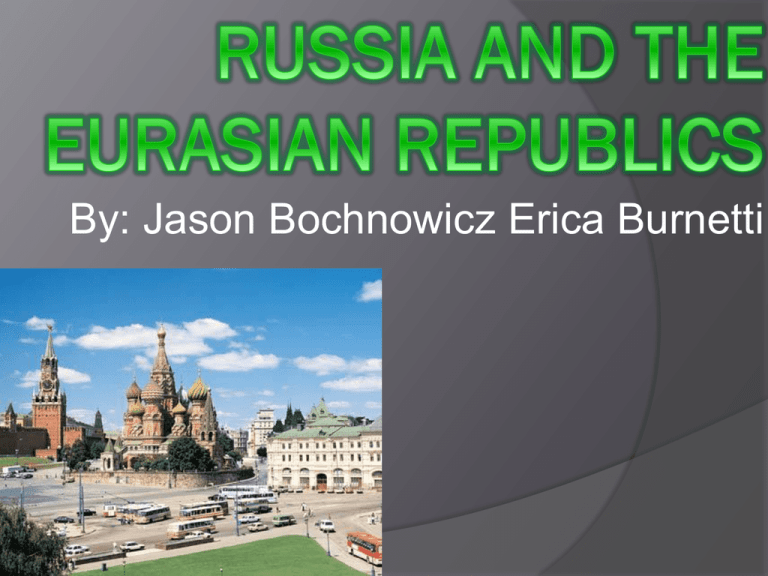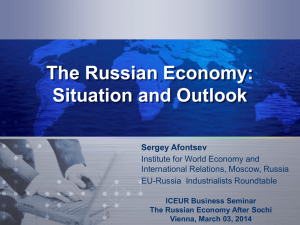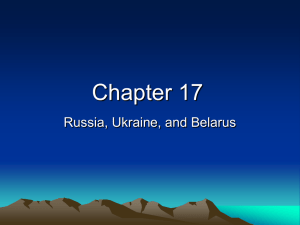Russia and the Eurasian Republics
advertisement

By: Jason Bochnowicz Erica Burnetti Permafrost- The layer of soil that stays frozen all year in a polar climate Taiga- A forest of evergreen trees that is south of the tundra in Russia Steppe- An area of grassland and fertile soil that is south of the taiga in Russia Chromium- A hard metal that is strong and does not rust easily Reform- changes meant to make things better Czar-The Russian word for Caesar, or ruler Abdicate- Give up Totalitarian-Someone who has a complete control over a country and its people Purge- To get rid of Cold War- A conflict of word and ideas between nations rather than armies Perestroika- A “reconstructing” or rebuilding of the Soviet political and economic systems Glasnost- The ‘openness’ or new freedom that aloud soviet citizens to speak out without fear of punishment Light Industry- Industry that focuses on the production of consumer goods such as appliances and clothing Heavy Industry- Industry that usually involves manufacturing based on large commercial items Cosmonauts- The name given to a Russian space explorer Displaced- To move from the usual or proper; to move people against their will The Land of Russia The largest country that is in the CIS is Russia. Russia is also one of the largest countries in the world. Russia also covers up 10% of land on the Earth. The big country can be divided into five different land regions the Great European Plain, the Ural Mountains, the West Siberian Uplands, the Central Siberian Plateau, and last but not least the East Siberian Uplands. Russia has two large cities and they are Moscow and St.Petersburg. The Great European Plain covers a lot of Russia’s land in Europe. East of the Great Plain are the Ural Mountains which is one of the five land regions. They form a boundary between the European and Asia which are parts of Russia. The Mountains run north and south from the Arctic Ocean to the Kazakhstan. To the east of the Ural Mountains are the West Siberian Plain. The huge plain covers more than one million square miles but it doesn’t go higher than 500 above the sea level. Ukraine is about the size of Texas which covers more than 233,00 square miles. Ukraine has flat land which was filled with steppes. The steppes are part of a large plain that travels from the southern Ukraine to the central Asia, most of the plains in central Asia are dry. Ukraine also has a lot of fresh water because many of the streams run through Ukraine. The Black sea which is in Ukraine has been badly polluted and Dr. Lawrence Mee who is a scientist says that the Ukrainians have to start protecting and stop polluting it. To the north of Ukraine is a place called Belarus. Belarus’s rivers, streams, and lakes are very important natural resources. The people in Belarus use the river to create something that is called hydroelectric power. One-third of Belarus is filled with forest. More than 10,00 different types of animals and plants can be found in the Belarus’s forests. The Caucasus Mountains cut across 700 miles between the Black and Caspian Seas. The mountains include Mt.Elbrus which is the highest point in Europe, it is 18,510 feet tall. The region of the former Soviet Union includes the countries of Georgia, Azerbaijan, Armenia, and some of the southern Russia. The mountains cover northern and eastern Georgia. Armenia is a land of rugged mountains and volcanoes. Along the shores of the Caspian sea the workers drill for oil. The people in Azerbaijan call the country the “land of fire.” Many people believe that visitors gave Azerbaijan this name. Across Caspian from Azerbaijan are Kazakhstan, Turkmenistan, Uzbekistan, Tajikistan, and last but not least Kyrgyzstan. Many CIS countries have very large areas of fertile plains ideal for farming. Kazakhstan is half the size of the United States and it is the second largest country in the CIS. Kazakhstan’s climate is very harsh with cold winters and extremely hat summers. For thousands of years nomadic groups travel through land moving in search of very few vegetations. Today many natural resources have been put to very few use. The country’s rich natural resources have remained untouched. Kazakhstan also has one of the world largest supple of gold. The country of Kazakhstan also faces a very special environment problem. The environment problem is the destruction of the Aral sea. The sea is located on the boarder between Kazakhstan and Uzbekistan. The changes in the direction of the Syr Darya and Amu Darya Rivers that have been drying up the Aral sea. The ships that used to be in the Aral sea are now to look like they are in the middle of the desert. In the A.D. 400s the Slavic people settled in Eastern Europe and then soon they started to make their way over to which is now Russia. The Slavs were farmers, cattle herders, and also the craftsman people. One of the settlements which was Novgorod which was a trading center. Novgorod is near what is today the Russian city St. Petersburg. In A.D. 862 a Viking named Rurik led an invasion of Novgorod. The Viking Rurik established a kingdom of Kievan Rus. The city of Kiev later became its capital. In the year of 1222 the Mongols invaded the capital of Kiev. The Mongols conquered Kiev and ruled it for 200 years until year of 1480. In that year the Slav prince named Ivan lll took control of Kiev. Ivan was also called Ivan the great and was the first true ruler of Russia. Ivan’s grandson called Prince Ivan lV later became the first czar of Russia. During the early 1800s Russia suffered from economic problems. The hard period which is called the times of troubles slowed down Russia’s growth By the end of the 1600s Western Europe started to become a modern society while Russia has changed just a little since the Middle Ages. A new leader who was called Peter the Great became a czar in the late 1600s. He built schools, libraries, museums, and also factories. He has also expanded Russia’s borders so now the people in Russia had new access to new trade routes. When Peter’s grandson later became leader if Russia. Peter was a really bad leader and people wanted him gone. Later he got assassinated and his wife Catherine became the new leader. She was the first person to get a smallpox vaccination. By the end of her leadership the Russians have seen very little change. The czar’s and also the nobles had all of Russia’s wealth and also its power. The last czar who was named Nicholas ll was brought into power in 1894. In January 1905 people came to his castle to demand better living conditions and than soldiers surrounded the castle and fired at the demanding crowd. That day became the Bloody Sunday. The Russians went on strike after all the killings. They quit working until their demands were met and Nichols gave very few of the people their demands. The government adopted a constitution and it formed a law making called Duma. On March 2 1917 Bolsheviks forced Nicholas to give up his spot as ruler. In July 1918 Lenin ordered Nicholas and his family to death. After 300 years the rule of the czars have ended. In 1922 the Bolsheviks formed the Union of Soviet Socialist Republics. The Union stretched from the Baltic and the Black Seas in the west to the Pacific Ocean in the east. It ruled 15 republics and the largest of the 15 was Russia. When someone named Lenin in 1924 a guy named Joseph Stalin became the new leader of the Union. He set up collectives in Russia and he ordered the people to give their land to the government. Those who refused were killed and soon he controlled every person in the Union. He ordered his agents to kill the people that he saw as a threat to the communism. Shortly before World War 2 the Union formed an alliance with Nazi Germany. Hitler went against the agreement and started attacking Russia. By the end of the war the Soviets and their allies began to disagree. When World War 2 ended the Union took control of Eastern Europe. The leaders that ruled after Stalin tried to extend communism beyond the Eastern Europe. As a result of the United States and other countries working to stop communism form spreading and this started a new war. This war became known as the Cold War. Each country feared by being attacked by another one so they built large supplies of dangerous weapons. The Soviet Union spent about one-third of its country’s GDP on the military. Precious natural resources had to be sold to pay for food and other things. Communist countries in Eastern Europe also wanted more freedom. Gorbachev finally realized that the Union could no longer control the countries. In the beginning of 1989 the people got their way and in that year communism end in Poland and soon in other countries in Europe became independent too. People in the Union wanted more than just the communism recalled they also wanted democracy but the communists feared this idea. So they fought to keep control of Russia. In December 1991 Gorbachev stepped down as leader and the Russian president Boris Yelistin became the leader. In May 2000 Vladimir Putin won the election as the new leader of Russia. His primary or 1st goal was to increase wealth and the standard of living for all Russian people. People of many different cultures and backgrounds make up the population of the CIS. Most people in Russia, Ukraine, and Belarus have Slavic ancestors. At least 70% of the people in the CIS speak Russian. Almost every country in the CIS speak their own language. The countries of the CIS have a very rich cultural history. Folk art and music are common and a well known kind of Russian folk art is the matryoshka which is a series of wooden dolls that vary in size. Many people think chess is just a game but people in the former Union think that is a sport. Chess players from Georgia and Russia are international chess champions. Food in the region varies from country to country. A dinner guest will probably get borschet, a soup of reed beets, and maybe also some meat. People in Azerbaijan eat a variety of breads, fruits, and also grains. The Ukrainians are very drawn to sausages and other meats. Potatoes are also a very important part of the diet in many peoples life. Religion practice is on the rise in Russia and the former Union republics. The Soviet don’t allow people to practice their religion freely. After the Union collapsed the people could practice religion freely. People in Chechnya also want to have independence. The end of communism has brought a lot of changes in the economy. The government sold many of the factories, farms, and other business to private owners and they were called light industry. Privately owned companies now own many of the heavy industry factories. Other heavy industries sell cars, boats, and farm equipment to consumers. Under communism all of the citizens were guaranteed a job. Some people didn’t have a choice on which job they picked. After the end of communism people didn’t have a choice of their job. Now that communism has ended many people in the CIS are unemployed. The government faced new problems. They didn’t have enough money to pay for all of the government workers. Many people lost their jobs because of that. By the mid-1990s nearly 12% or 18 million people couldn’t find a jobs. The economy began to improve in the early 2000s, More people had jobs and small businesses were growing and some factories also. Russia’s space program is even using making new advances. More than 40 years ago the Russians were the leaders in space exploration. Later in the Soviet period there was very little money for such an expensive program. The road for to a better economy has not been very easy for the people in the CIS. Russian’s urban areas are home to many people of many cultures. People used to move to large towns and cities in search of work. The Soviets moved people against their own will. During World War 2 the people left their homes to escape the fighting and many came to live in Moscow and other large cities. Today cities are still growing. The Russian capital of Moscow has become a very fast paced and a modern city. About 10 million people live there and earn more than 70% of Russia’s income. Businesspeople from around the world to talk investments and also Russia’s future. While many of the Russian people suffer economically but some were very successful. Selling natural resources such as oil also brings wealth to people and the government. A new social class of wealthy citizens which is called “New Russians.” Traditional life has never been lost. One of the neighborhoods called Arbat have cafes where they can eat borscht, black bread, sausage, and also other favorites. Each year on June 12 the Russians celebrate their independence form the Soviet Union. THANK YOU FOR WATCHING OUR SLIDE SHOW!!!!!!!!!!!!!!!!









